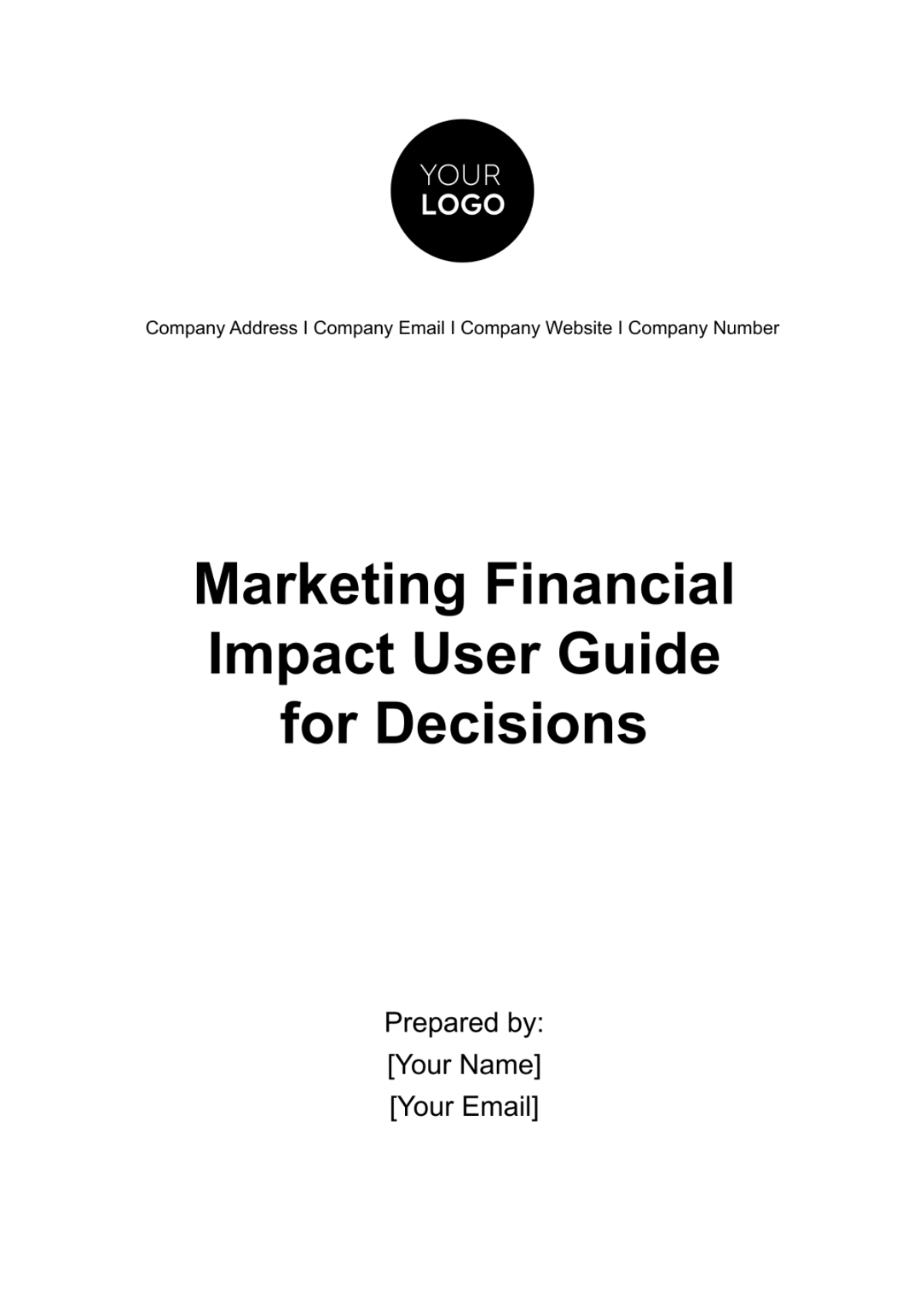Free Marketing Financial Impact User Guide for Decisions

I. Purpose and Scope
In today's ever-evolving business landscape, the critical interplay between marketing decisions and financial outcomes cannot be overstated. A profound understanding of this relationship is no longer an option but a necessity for marketing professionals aiming to steer their organizations toward financial success.
A. Purpose and Scope
This user guide is for marketing strategies and financial impact. Its primary purpose is to equip marketing professionals with the knowledge and tools required to make decisions that don't just drive brand awareness but also bolster the bottom line.
For our target audience, comprising marketing managers, analysts, and executives, this guide serves as an invaluable resource. It's tailor-made for those tasked with planning, executing, and optimizing marketing campaigns in an environment where data-driven decision-making is paramount.
B. Overview of the Guide's Contents
Within these digital pages, we will navigate through a comprehensive exploration of vital aspects that bridge the gap between marketing and finance. Drawing upon statistical data, case studies, and research findings, we will unravel the intricacies of financial metrics that truly matter. This includes dissecting how marketing budgets impact profitability, deciphering ROI calculations, and understanding the nuances of performance tracking.
Furthermore, we will embark on a journey toward continuous improvement, elucidating strategies that empower marketing professionals to adapt, pivot, and refine their approaches in real-time. It's a roadmap that leads to a brighter future for both marketing and finance teams, as they collaborate in pursuit of overarching organizational objectives.
In the coming sections, we will delve deeper into providing practical insights and actionable best practices to empower marketing professionals in their quest for financial impact and sustainable growth. Welcome to a comprehensive guide that transforms marketing decisions from mere tactics into strategic drivers of financial success.
II. Understanding Marketing Financial Impact
In the intricate world of modern marketing, understanding the financial impact of your decisions is not just a skill but a competitive advantage. In this section, we'll unravel the complexities of this essential relationship, providing you with the insights and tools necessary to navigate this terrain effectively.
A. Key Financial Metrics
To begin our journey, we must first grasp the fundamental financial metrics that underpin marketing's impact on the bottom line. These metrics serve as the compass, guiding us through the often intricate financial landscape:
Return on Investment (ROI) - ROI is the litmus test of marketing efficiency, revealing how effectively your marketing dollars translate into profit. We'll dissect ROI, showing you how to calculate it, interpret the results, and optimize your marketing strategies accordingly. |
Return on Advertising Spend (ROAS) - ROAS delves deeper into the effectiveness of your advertising efforts, helping you gauge the returns from specific ad campaigns. Understanding ROAS is pivotal in making informed decisions about where to allocate your marketing budget. |
Customer Acquisition Cost (CAC) - CAC quantifies the investment required to acquire a new customer. By mastering this metric, you can fine-tune your customer acquisition strategies and make cost-efficient decisions. |
Customer Lifetime Value (LTV) - LTV casts a long-term perspective on your customers, providing insights into their enduring value. We'll show you why this metric is indispensable for strategic planning and how it can guide your decisions to optimize marketing's financial impact. |
B. The Relationship Between Marketing and Finance
Once equipped with these metrics, we'll dive deeper into understanding how marketing wields its influence on financial performance:
Exploring the Influence of Marketing on Finance - Delve into the mechanisms through which marketing efforts contribute to revenue generation, enhance profitability and influence cash flow dynamics. By understanding these connections, you can craft strategies that harness marketing's full financial potential. |
Aligning Marketing Goals with Financial Objectives - To create financial impact, alignment is key. We'll explore how to set marketing objectives that seamlessly align with your organization's broader financial goals. By doing so, you'll ensure that your marketing investments are not just tactical but strategic contributors to the bottom line. |
In the pages ahead, we'll break down these concepts further, offering practical guidance, real-world examples, and expert insights. Our aim is to empower you with the knowledge and tools needed to navigate the nexus of marketing and finance with confidence and precision, ultimately driving your organization's growth and success. Welcome to a journey where marketing isn't just an expense—it's an investment in your financial future.
III. Using Data for Informed Marketing Decisions
In the contemporary realm of marketing, data transcends mere buzzword status; it's the foundation upon which successful strategies are built. This section serves as your comprehensive guide to navigating the world of data-driven decision-making, where precision and insight reign supreme.
A. Data Sources and Collection
To embark on this data-driven journey, we must first understand the origins of our insights, as well as the fundamental importance of data accuracy:
Discovering Common Data Sources - Data is crucial to informed decision-making. We'll take a detailed look at the various sources from which you can draw data, whether it's web analytics, customer databases, or sales records. Knowing where to obtain your data is crucial in shaping effective marketing strategies. |
The Significance of Accurate Data Collection - However, data alone is not enough; it must be accurate and reliable. Here, we explore the far-reaching consequences of relying on inaccurate data, from misguided campaigns to squandered budgets. We'll equip you with strategies to ensure data quality, emphasizing the critical importance of this foundation for data-driven decision-making. |
B. Data Analysis and Interpretation
With a solid understanding of data collection, it's time to extract actionable insights from your data. Here, we explore the methodologies and practical applications of data analysis:
Methods for Analyzing Marketing Data - We'll introduce you to an array of data analysis techniques, from descriptive analytics that illuminate historical trends to predictive modeling that anticipates future market shifts. By mastering these methods, you'll gain the ability to unlock valuable insights buried within your marketing data. |
Real-world Examples of Data-informed Decisions - Data is not an abstract concept; it's a powerful tool with real-world applications. We'll paint a vivid picture by presenting concrete examples of how data-driven insights can guide marketing decisions, leading to more effective campaigns and, ultimately, enhanced financial outcomes. |
In the data-driven age, informed marketing decisions are the key to success, and this section is your gateway to mastering this transformative approach. Welcome to a world where data is not just information but a compass that steers marketing strategies toward financial excellence.
IV. Making Financially Sound Marketing Decisions
In the realm where marketing meets finance, making decisions that resonate with fiscal responsibility is pivotal. This section acts as your compass, guiding you through the intricate landscape of budgeting, resource allocation, and the all-important Return on Investment (ROI).
A. Budgeting and Resource Allocation
Before embarking on any marketing campaign, a well-structured budget is the cornerstone of success:
Navigating the Budgeting Process - We will walk you through the intricacies of crafting budgets that not only reflect your financial objectives but also ensure that every marketing dollar is invested wisely. |
Efficient Resource Allocation - Effective resource allocation is key to optimizing ROI. Here, we delve into the art of allocating resources across diverse marketing channels and initiatives, ensuring that each investment yields the maximum return. |
B. Return on Investment (ROI) Calculation
ROI is the true litmus test of marketing success, and mastering it is a game-changer:
Calculating ROI for Marketing Campaigns - We provide a step-by-step roadmap for calculating ROI, demystifying this crucial metric. Real-world examples and templates will guide you through the process, making it tangible and actionable. |
Enhancing ROI: Best Practices - ROI is not static; it's a dynamic figure that can be improved. We'll explore best practices for enhancing ROI, from campaign optimization and audience targeting to prudent cost management. |
As you dive deeper into this section, you'll not only acquire the knowledge and skills to navigate the financial intricacies of marketing but also the strategic insights needed to make financially sound decisions. The nexus of marketing and finance is where opportunities are seized and lost; this section is your key to unlocking the former and averting the latter. Welcome to a world where marketing decisions are not just creative but also financially astute—a world where success is measured not just in engagement but in the bottom line.
V. Monitoring and Optimizing Marketing Financial Impact
As the established maxim goes, "What gets measured gets managed." In this section, we shift our focus to the crucial aspect of monitoring and optimizing marketing financial impact, where data-driven decisions come full circle to drive ongoing success.
A. Performance Tracking
To make informed decisions, it's imperative to have a finger on the pulse of your marketing campaigns:
Methods for Tracking Marketing Campaign Performance - We'll explore the array of tools and techniques available to monitor and measure campaign impact. From defining Key Performance Indicators (KPIs) to utilizing intuitive dashboards, you'll gain insights into how to keep a close eye on your marketing strategies' effectiveness. |
Templates and Tools for Performance Monitoring - In our commitment to practicality, we provide downloadable templates and tools that simplify the performance tracking process. These resources streamline your efforts, ensuring that monitoring is both efficient and effective. |
B. Continuous Improvement
In the dynamic landscape of marketing, stagnation is the enemy of financial success:
The Significance of Ongoing Optimization - We delve into the compelling reasons why continuous improvement is not just a buzzword but a critical factor in long-term financial success in marketing. By understanding this importance, you'll be prepared to adapt and thrive in the ever-evolving marketing sphere. |
Strategies for Consistently Improving Marketing Financial Impact - We provide actionable strategies for consistently achieving better financial results over time. From agile adaptation to refined targeting, these tactics empower you to make incremental but impactful enhancements to your marketing strategies. |
As you explore this section, you'll come to appreciate that monitoring and optimization are not just tasks to check off but ongoing processes that drive sustainable success.
VI. Conclusion and Additional Resources
As we near the end of this comprehensive guide on marketing financial impact, let's take a moment to recap what we've covered and explore the resources available to further enhance your understanding of this vital topic.
A. Recap of Key Takeaways
In this journey through the intricate intersection of marketing and finance, we've explored the following key takeaways:
Understanding Marketing Financial Impact: The relationship between marketing decisions and financial outcomes is paramount in today's business landscape.
Data-Driven Decision-Making: Data is the foundation of informed marketing decisions, and its collection, analysis, and interpretation are crucial.
Making Financially Sound Decisions: Budgeting, resource allocation, and ROI calculations are pivotal in ensuring marketing strategies align with financial goals.
Monitoring and Optimization: Continuous improvement and performance tracking are essential for long-term financial success in marketing.
B. Additional Resources
To continue your journey of learning and mastery in the field of marketing financial impact, we recommend exploring the following resources:
Books: Dive deeper into the subject with books such as "Marketing Metrics: The Definitive Guide to Measuring Marketing Performance" by Paul W. Farris, Neil T. Bendle, and others.
Articles: Stay updated with the latest trends and insights by following marketing and finance articles in reputable publications like Harvard Business Review and MarketingProfs.
Online Courses: Consider enrolling in courses on platforms like Coursera, LinkedIn Learning, or Udemy that focus on marketing analytics and financial impact.
Marketing Tools: Explore marketing analytics tools such as Google Analytics, HubSpot, or Adobe Analytics to implement data-driven decision-making.
C. Contact Information
For any inquiries, assistance, or further guidance related to marketing financial impact, please don't hesitate to reach out to our dedicated support team. You can contact us at [Your Company Email]/[Your Company Number].
This guide has equipped you with the knowledge and tools to navigate the intricate world where marketing decisions meet financial impact. We encourage you to continue exploring, learning, and implementing these insights to drive success in your marketing endeavors. Thank you for embarking on this educational journey with us, and we look forward to assisting you in your ongoing pursuit of marketing financial excellence.
- 100% Customizable, free editor
- Access 1 Million+ Templates, photo’s & graphics
- Download or share as a template
- Click and replace photos, graphics, text, backgrounds
- Resize, crop, AI write & more
- Access advanced editor
Navigate financial decisions with confidence using Template.net's Marketing Financial Impact User Guide for Decisions Template. This editable and customizable tool provides a comprehensive framework for assessing financial impacts. Easily adjust parameters in our Ai Editor Tool to align with your specific needs. Make informed decisions and drive financial success with ease.





























